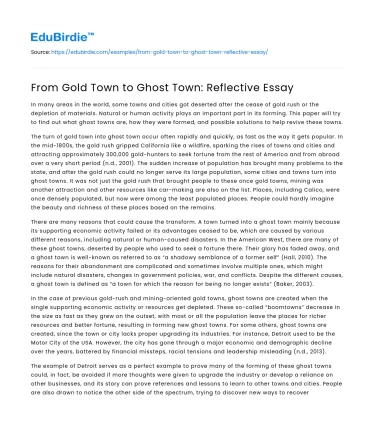In many areas in the world, some towns and cities got deserted after the cease of gold rush or the depletion of materials. Natural or human activity plays an important part in its forming. This paper will try to find out what ghost towns are, how they were formed, and possible solutions to help revive these towns.
The turn of gold town into ghost town occur often rapidly and quickly, as fast as the way it gets popular. In the mid-1800s, the gold rush gripped California like a wildfire, sparking the rises of towns and cities and attracting approximately 300,000 gold-hunters to seek fortune from the rest of America and from abroad over a very short period (n.d., 2001). The sudden increase of population has brought many problems to the state, and after the gold rush could no longer serve its large population, some cities and towns turn into ghost towns. It was not just the gold rush that brought people to these once gold towns, mining was another attraction and other resources like car-making are also on the list. Places, including Calico, were once densely populated, but now were among the least populated places. People could hardly imagine the beauty and richness of these places based on the remains.
Save your time!
We can take care of your essay
- Proper editing and formatting
- Free revision, title page, and bibliography
- Flexible prices and money-back guarantee
There are many reasons that could cause the transform. A town turned into a ghost town mainly because its supporting economic activity failed or its advantages ceased to be, which are caused by various different reasons, including natural or human-caused disasters. In the American West, there are many of these ghost towns, deserted by people who used to seek a fortune there. Their glory has faded away, and a ghost town is well-known as referred to as “a shadowy semblance of a former self” (Hall, 2010). The reasons for their abandonment are complicated and sometimes involve multiple ones, which might include natural disasters, changes in government policies, war, and conflicts. Despite the different causes, a ghost town is defined as “a town for which the reason for being no longer exists” (Baker, 2003).
In the case of previous gold-rush and mining-oriented gold towns, ghost towns are created when the single supporting economic activity or resources get depleted. These so-called “boomtowns” decrease in the size as fast as they grew on the outset, with most or all the population leave the places for richer resources and better fortune, resulting in forming new ghost towns. For some others, ghost towns are created, since the town or city lacks proper upgrading its industries. For instance, Detroit used to be the Motor City of the USA. However, the city has gone through a major economic and demographic decline over the years, battered by financial missteps, racial tensions and leadership misleading (n.d., 2013).
The example of Detroit serves as a perfect example to prove many of the forming of these ghost towns could, in fact, be avoided if more thoughts were given to upgrade the industry or develop a reliance on other businesses, and its story can prove references and lessons to learn to other towns and cities. People are also drawn to notice the other side of the spectrum, trying to discover new ways to recover the lost glory.
Some ghost towns can be indeed revived. In reality, a few ghost towns have been given a second life due to the effective implementation of strategies. These towns may be rich in history or tourism, which help them generate a new economy that supports their being and their local citizens. For example, in 1914, Walhalla, a city of Australia ceased to be popular and became deserted after its gold mine stopped operation, but luckily, due to its accessibility to other tourist attractions, it attracted a population surge and many more people to seek pleasure in tourism (n.d., 2006-2013). Other ghost towns were given a second chance and recover its holiday population due to its great place for filming its rich history. Interesting, there are also examples of ghost towns being revived owing to the ever-increasing streams of people who come as pilgrim, which include Foncebadón, a village in León, Spain (Aviva, 2001).
Moreover, many new industries should be brought back into town according to its distinctive location or species or resources.
However, common industries are hard to help in reconstructing a gold town as it used to be. Only upgrading industries that generate jobs and profits are needed as an effective strategy. These ghost town so often suffer from the lack of and depletion of resource – most unfortunately, many of them rely on one single resource, which brings extreme difficulties for solving the problems. But still, although many attempts have failed previously, continuous efforts should be made, for many of the ghost towns deserve a second chance for the potential it possesses. In comparison, the best way to revitalize a ghost town is to make the best of tourist attractions in these areas.
Knowing what ghost towns are, how they are formed, and some possible solutions to help revive these towns are important to help people effectively avoid the forming of new ghost towns and reviving some of them back, prompting more people to make further attempts and enrich related researches and studies.






 Stuck on your essay?
Stuck on your essay?

